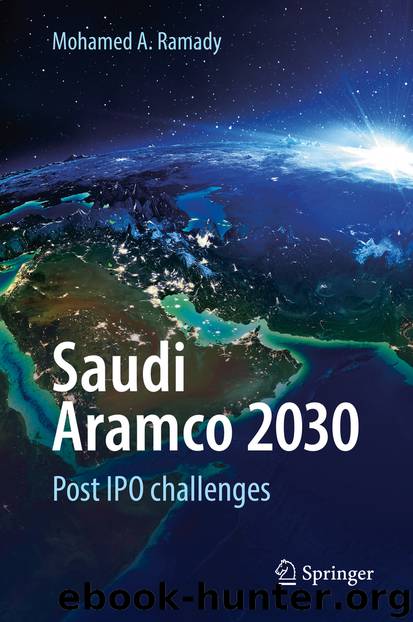Saudi Aramco 2030 by Mohamed A. Ramady

Author:Mohamed A. Ramady
Language: eng
Format: epub
Publisher: Springer International Publishing, Cham
Net proved reserves as at 31 Dec. 2016
Oil and condensate
NGL/LPG (mmbbl)
Sales gas (bcf)
Oil equivalent (mmboe)
• Estimated by Statoil
2033
372
14,637
5013
• Estimated by DeGolyer and MacNaughton
2244
324
13,685
5007
• Statoil deviation (%) from DeGolyer and MacNaughton estimates
(9.4%)
+14.8%
+6.9%
+0.12%
Source: Statoil Annual Report 2016, p. 46
As the above table indicates, Statoil’s estimated deviation from DeGolyer & MacNaughton was an overall negligible 0.12%, with conservative underestimations applied, except for gas sales.
The company’s conservatism has been guided by a clear corporate governance structure and a Board of Directors that are mostly composed of independent members, as will be discussed later, despite the fact that the Norwegian state plays a significant role in setting the country’s petroleum and licensing laws. The principal laws governing Statoil’s petroleum activities in Norway are the “Norwegian Petroleum Act” and the “Norwegian Petroleum Taxation Act.” Under the first act, the Norwegian Ministry of Petroleum and Energy is responsible for resource management and for administering petroleum activities in the Norwegian continental shelf (NCS). The main task of the Ministry is to ensure that petroleum activities are conducted in accordance with the applicable legislation and the policies adopted by the Norwegian parliament or the Storting, and decisions of the state. The Norwegian state’s policy as a majority shareholder in Statoil has been consistent: to ensure that petroleum activities create the highest possible value for the Norwegian state (Statoil 2016b). Besides this objective, there is a specific mandate, whereby Statoil markets and sells the Norwegian state’s oil and gas together with the company’s own production, and in this respect risks related to state ownership arise, something that has been highlighted earlier in this chapter. For Statoil, the interests of the majority shareholder, the Norwegian state, may not always be aligned with the interest of Statoil’s other shareholders, and this may affect Statoil’s policy decisions. Figure 4.16 sets out Statoil’s shareholding structure at year-end 2016.
Fig. 4.16Statoil shareholding as at 31 December 2016 (%). (a) Distribution of shareholders. (b) Free float breakdown
Source: Statoil Annual Report, 2016, p. 242
Download
This site does not store any files on its server. We only index and link to content provided by other sites. Please contact the content providers to delete copyright contents if any and email us, we'll remove relevant links or contents immediately.
International Integration of the Brazilian Economy by Elias C. Grivoyannis(99072)
The Radium Girls by Kate Moore(11975)
Turbulence by E. J. Noyes(7981)
Nudge - Improving Decisions about Health, Wealth, and Happiness by Thaler Sunstein(7659)
The Black Swan by Nassim Nicholas Taleb(7058)
Rich Dad Poor Dad by Robert T. Kiyosaki(6514)
Pioneering Portfolio Management by David F. Swensen(6257)
Man-made Catastrophes and Risk Information Concealment by Dmitry Chernov & Didier Sornette(5957)
Zero to One by Peter Thiel(5736)
Secrecy World by Jake Bernstein(4701)
Millionaire: The Philanderer, Gambler, and Duelist Who Invented Modern Finance by Janet Gleeson(4425)
The Age of Surveillance Capitalism by Shoshana Zuboff(4248)
Skin in the Game by Nassim Nicholas Taleb(4205)
Bullshit Jobs by David Graeber(4141)
The Money Culture by Michael Lewis(4135)
Skin in the Game: Hidden Asymmetries in Daily Life by Nassim Nicholas Taleb(3962)
The Dhandho Investor by Mohnish Pabrai(3725)
The Wisdom of Finance by Mihir Desai(3697)
Blockchain Basics by Daniel Drescher(3541)
